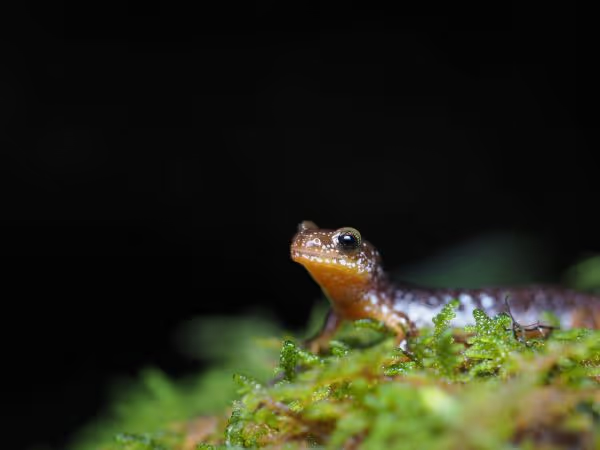Columbia Torrent Salamanders


Columbia torrent salamanders (Rhyacotriton kezeri) are a species of torrent salamanders endemic to the Pacific Northwest. They are found in the Coast Range in southwestern Washington and northwestern Oregon. In Washington, their range is limited to the Willapa Hills, no further north than the Chehalis River.
These salamanders are aquatic and spend most of their lives in or near water. They live in headwater streams, springs, waterfalls, and seeps with a gravel and cobble substrate. They prefer cooler temperatures and thus are more commonly found in mountainous areas and coastal coniferous forests. They generally do not stray far from a water source. Since their lungs are very small, they breathe primarily through their skin and need to keep their skin moist in order to do this. However, they may be found away from the water if the surrounding forest environment is wet enough.
Columbia torrent salamanders are 3-4.5 inches in total length. They have brown coloration on their backs and orange to orange-yellow on their undersides. They have white speckling that is concentrated at their sides and may have black flecking as well. Their limbs, snout, and tails are relatively short. Like other torrent salamanders have prominent eyes and adult males have prominent squared lobes at the base of their tails. Males are slightly smaller than females.
Larval salamanders are entirely aquatic. They have external gills and a fin tail, though they are fairly small. Their bellies are white to yellow-orange in color. As they develop, their gills and tails shrink and their belly color darkens.
Columbia torrent salamanders can look very similar to Olympic torrent salamanders (Rhyacotriton olympicus), but they can be distinguished by their range. Olympic torrent salamanders can only be found in the Olympics while Columbia torrent salamanders can only be found in the Willapa Hills and their ranges do not overlap.
Invertebrates make up the entirety of Columbia torrent salamanders’ diet. Larval salamanders feed on aquatic invertebrates, such as copepods. Adults have a more varied diet that includes aquatic and semi-aquatic invertebrates, including spiders, beetles, and flies.
Little is known about the reproductive behaviors of Columbia torrent salamanders. There have currently only been five nests found and it is not known to what extent parents care for their eggs. Eggs are laid individually in concealed locations in cool, slow moving water. Clutch size is estimated to be about 11 eggs. More than one female may lay eggs in a particular area.
The incubation period lasts seven to nine months, the larval stage lasts over two years, and it is thought to take four years to reach sexual maturity. Their lifespans are known to be long, though their exact maximum lifespans are not known.
References
Hammerson, G., Popper, K. J., & Hallock, L. (2024, April 5). Rhyacotriton kezeri. NatureServe Explorer. https://explorer.natureserve.org/Taxon/ELEMENT_GLOBAL.2.103633/Rhyacotriton_kezeri
Oregon Conservation Strategy. (n.d.). Columbia torrent salamander. https://www.oregonconservationstrategy.org/strategy-species/columbia-torrent-salamander/
Washington Department of Fish & Wildlife. (n.d.). Columbia torrent salamander. https://wdfw.wa.gov/species-habitats/species/rhyacotriton-kezeri
© Laura Caldwell, April 2024
Touch whale bones, examine shipwreck artifacts and connect with the coast's living history.

Support our mission, get involved in educational programs, or contribute through donations and volunteering.